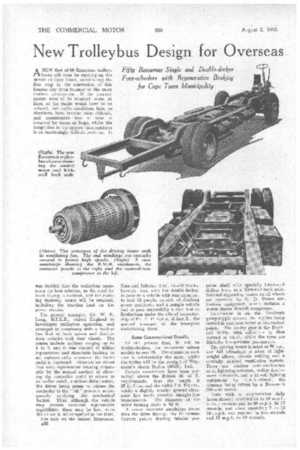New Trolleybus Design for Overseas
Page 28

If you've noticed an error in this article please click here to report it so we can fix it.
Fifty Ransomes Single and Double-decker Four-wheelers with Regenerative Braking for Cape Town Municipality
ANEW fleet of 50 Ransomes trolley, buses will soon be running on the streets of Cape Town, constituting the first step in the conversion of this famous city from tramcar to the more modern conveyance. If the tramcar system were to be retained, some, at least, of the tracks would have to be relayed, but traffic conditions here, as elsewhere, have become more difficult, and considerable loss of time is incurred by trams at loops, whilst the congestion in the narrow thoroughfares is an increasingly difficult problem. It
was decided that the trolleybus represents the best solution, as the need for track laying is avoided, and the existing tramway assets will be retained, including the traction load on the power station.
The general manager, Mr. W. F. Long, M.I.E.E., visited England to investigate trolleybus operation, and arranged to commence with a trolleybus fleet of both saloon and doubledeck vehicles with four wheels. The routes include inclines ranging up to 1 in 9, and it was decided to utilize regenerative and rheostatic braking to act automatically. whenever the brake pedal is depressed. Observation shows that with regenerative braking obtainable by the normal method of allowing the controller pedal to return to an earlier notch, a serious defect exists, the driver being prone to release the controller to the " off " position, subsequently applying the mechanical brakes. Thus, although the vehicle may possess excellent regenerative capabilities, these may be lost, since the driver is not compelled to use them.
The task set the maker. Ransomes,
B22
Sims and Jefferies, Ltd., Orwell Works, Ipswich, was, with the double-decker, to provide a vehicle with rear entrance, to seat 62 people, capable of climbing severe gradients,. and a sample vehicle had to pass successfully a road test at Rotherham under the official inspectorship of Mr. T. P. Sykes, M.Inst.T., the general manager of the transport undertaking there:
Some Constructional Details.
Of the present fleet, 30 will be double-deckers, the remainder saloon models to seat 39. The chassis in each case is substantially the same, whilst the bodies will be the product of Weymann's Motor Bodies (1925), Ltd.
Certain concessions have been permitted above the British M. of T. requirements, thus the length is 27 ft. 6 ins, and the width 7 ft. 10i ins., whilst a slightly smaller ground clearance has made possible straight-line transmission. The diameter of the outer turning circle is 52 ft.
A motor mounted amidships transmits the drive through the RansomesGarrett patent floating tubular pro peller shaft with specially lubricated sliding keys, to a Kirkstall back axle. Internal-expanding brakes on all wheels are operated by G. D. Peters airbraking equipment, which includes a motor-driven Reavell compressor.
Lubrication is on the Tecalemit group-nipple system, the nipples being carried in cast-iron boxes at convenient points. The trolley gear is the Brecknell Willis, with collection by shoe instead of wheel, whilst the tyres are Michelin low-pressure pneumatics.
The driving motor is rated at 80 h.p., and full advantage is taken of lightweight alloys, electric welding and a carefully studied ventilation system. There are wireless anti-interference coils, lightning arresters, trolley dewirement indicators, and a 24-volt lighting equipment by C.A.V.-Bosch, the dynamo being driven by a Ransomes 500-volt motor.
Tests with a single-decker fully laden showed acceleration to 10 m.p.h. in four seconds and to 20 m.p.h. in 15 seconds, and when ascending 1 in 12 10 m.p.h. was reached in five seconds and 15 m.p.h. in 10 seconds.












































































